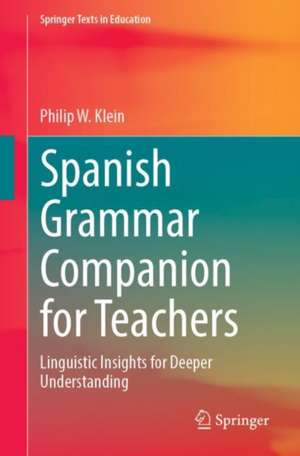Spanish Grammar Companion for Teachers: Linguistic Insights for Deeper Understanding
Autor Philip W. Kleinen Limba Engleză Paperback – iun 2022
It is not intended for those beginning to learn Spanish (since it skips the basics to focus on the “rough spots”), but is directed to those who know Spanish well, yet need to overcome their nagging limitations in obtuse areas, e.g. subjunctive, reflexives, pronouns (neuter, relative, personal), adjective placement, ser/estar, preterite/imperfect, commands, gender, passive and impersonal expressions. There arespecial sections devoted to words easily confused with each other, use of the accent mark, irregular verbs, and sentence structure.
It is useful for self-study and to supplement texts in composition, culture and linguistics courses. It benefits native-speaker teachers unfamiliar with the “why” of their language, as well as buttressing anglophone instructors of scant linguistic background. The result is a better prepared teacher and a more promising learning experience for the students.
Preț: 426.86 lei
Preț vechi: 514.28 lei
-17% Nou
Puncte Express: 640
Preț estimativ în valută:
81.68€ • 85.28$ • 67.60£
81.68€ • 85.28$ • 67.60£
Carte disponibilă
Livrare economică 15-29 martie
Livrare express 01-07 martie pentru 30.21 lei
Preluare comenzi: 021 569.72.76
Specificații
ISBN-13: 9783030841102
ISBN-10: 3030841103
Pagini: 224
Ilustrații: XIII, 232 p. 5 illus., 2 illus. in color.
Dimensiuni: 178 x 254 x 21 mm
Greutate: 0.44 kg
Ediția:1st ed. 2022
Editura: Springer International Publishing
Colecția Springer
Locul publicării:Cham, Switzerland
ISBN-10: 3030841103
Pagini: 224
Ilustrații: XIII, 232 p. 5 illus., 2 illus. in color.
Dimensiuni: 178 x 254 x 21 mm
Greutate: 0.44 kg
Ediția:1st ed. 2022
Editura: Springer International Publishing
Colecția Springer
Locul publicării:Cham, Switzerland
Cuprins
Language Learning.- Verb Forms and Functions.- Nouns and their Modifiers.- Ways of BEing.- Personal Pronouns.- Prepositions and Adverbs.- Subjunctive.- Relative Clauses and Relative Pronouns.- Questions, Commands and Reported Speech.- Comparison, Negation and Coordination.- Passives and Impersonal Expressions.- Appendix A: The Spanish Written Accent.- Appendix B: Verbal Irregularity.- Appendix C: Sentences and their Structures.- Appendix D: Vocabulary Distinctions (words frequently confused with each other).
Notă biografică
Philip W. Klein is Associate Professor Emeritus of Spanish Language and Linguistics at the University of Iowa (USA). He holds a Ph.D. in linguistics from the University of Washington and has wide experience living and working in both Spain and Spanish America. He has taught Spanish language (grammar and composition) and Hispanic linguistics (phonology and morphosyntax) at universities in Canada and in the USA for many years and is author of numerous publications in Spanish linguistics and pedagogy.
Textul de pe ultima copertă
This textbook boosts the confidence of persons teaching Spanish as a second language, who may lack confidence in their understanding of tricky areas of expression. Their previous training did not enable them to control (much less explain to others) the many “danger zones” which challenge graduate students serving as teaching assistants, in-service teachers, and others who use Spanish professionally. It offers original and insightful analyses, abundant examples and helpful English comparisons. It disarticulates the machinery of grammar into manageable parts.
It is not intended for those beginning to learn Spanish (since it skips the basics to focus on the “rough spots”), but is directed to those who know Spanish well, yet need to overcome their nagging limitations in obtuse areas, e.g. subjunctive, reflexives, pronouns (neuter, relative, personal), adjective placement, ser/estar, preterite/imperfect, commands, gender, passive and impersonal expressions. There are special sections devoted to words easily confused with each other, use of the accent mark, irregular verbs, and sentence structure.
It is useful for self-study and to supplement texts in composition, culture and linguistics courses. It benefits native-speaker teachers unfamiliar with the “why” of their language, as well as buttressing anglophone instructors of scant linguistic background. The result is a better prepared teacher and a more promising learning experience for the students.
It is not intended for those beginning to learn Spanish (since it skips the basics to focus on the “rough spots”), but is directed to those who know Spanish well, yet need to overcome their nagging limitations in obtuse areas, e.g. subjunctive, reflexives, pronouns (neuter, relative, personal), adjective placement, ser/estar, preterite/imperfect, commands, gender, passive and impersonal expressions. There are special sections devoted to words easily confused with each other, use of the accent mark, irregular verbs, and sentence structure.
It is useful for self-study and to supplement texts in composition, culture and linguistics courses. It benefits native-speaker teachers unfamiliar with the “why” of their language, as well as buttressing anglophone instructors of scant linguistic background. The result is a better prepared teacher and a more promising learning experience for the students.
Caracteristici
Makes the toughest areas of Spanish grammar more transparent, manageable Employs the familiar, accessible language of traditional grammar A godsend for K-12 teachers and graduate teaching assistants with limited background
